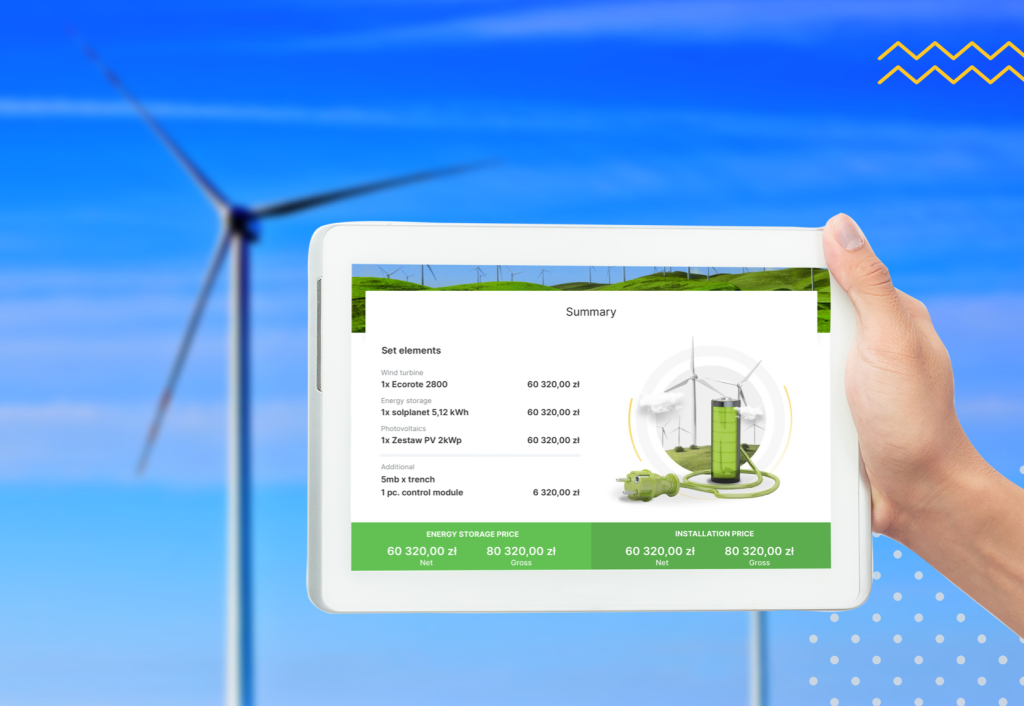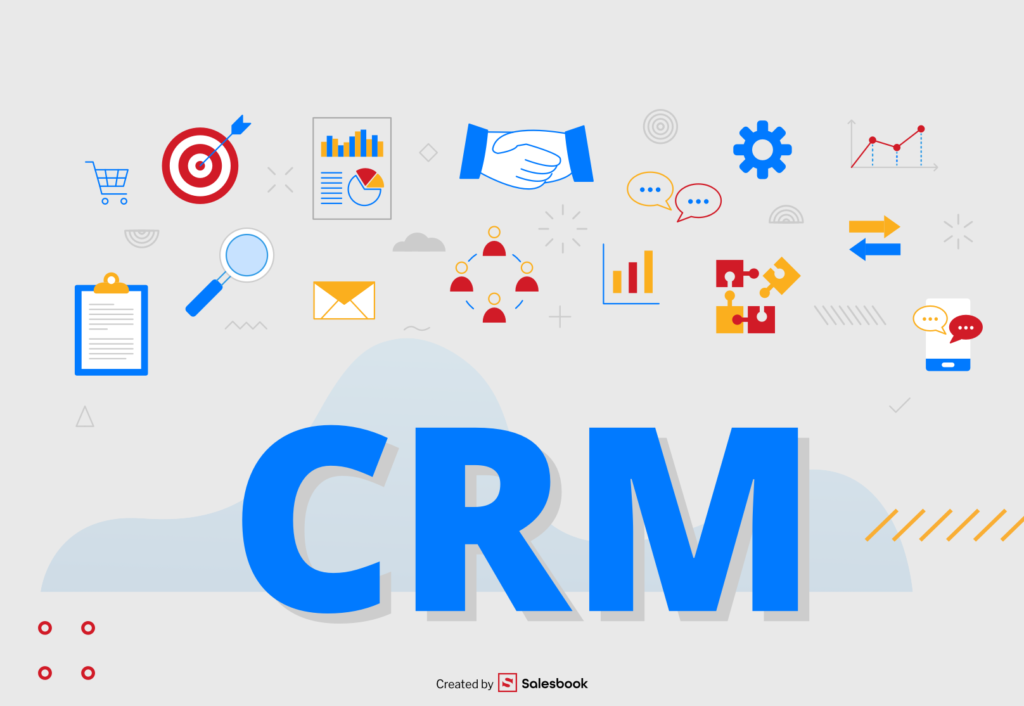Automated follow up after meeting with client. Save your time and focus on a sales process

Are you aware that 80% of sales transactions involve sending follow-up e-mails five times before a potential customer decides to buy a product or service? It is essential not only to send an e-mail but also to write an engaging text. Luckily, by using automation, you can save time and not have to work on the details of such communication.
What is a follow-up e-mail?
A follow-up e-mail is a message sent to a prospective customer by a sales rep after initial contact. It should contain the most important information about your product or service and a summary of arrangements between the two parties.
A good follow-up e-mail is also enriched by the next steps of cooperation. Furthermore, it is an element of supporting a sales process and customer interactions. It arouses interest in the company’s offer and defines the future collaboration between salespeople and potential customers. Moreover, if a client responds to such an e-mail, a salesperson can get to know better their needs and problems.

If you send follow-up e-mails, you should remember that due to many reasons, communication with your customer can be disturbed. Therefore, you must send more than one message to your potential customers. Unfortunately, practice shows something different.
Messages to prospective customers and their underestimated role
One of the reasons that sales reps do not appreciate the role of follow-up e-mails, is a belief that a potential customer is usually interested in a product after a meeting. They are certain that they are professionals who know how to guide prospective customers through the sales funnel stages.
At this time, appropriate departments optimize sales and marketing efforts to generate leads. As a consequence, if a client has already had a meeting, a sales rep can forget about them. However, the statistics show that it is a big mistake.
According to IRC Solutions, only 2% of deals are closed during a first meeting. Furthermore, in 80% of cases, a sales rep has to send a follow-up e-mail five times before a potential customer makes a decision (the recent Invespcro data).
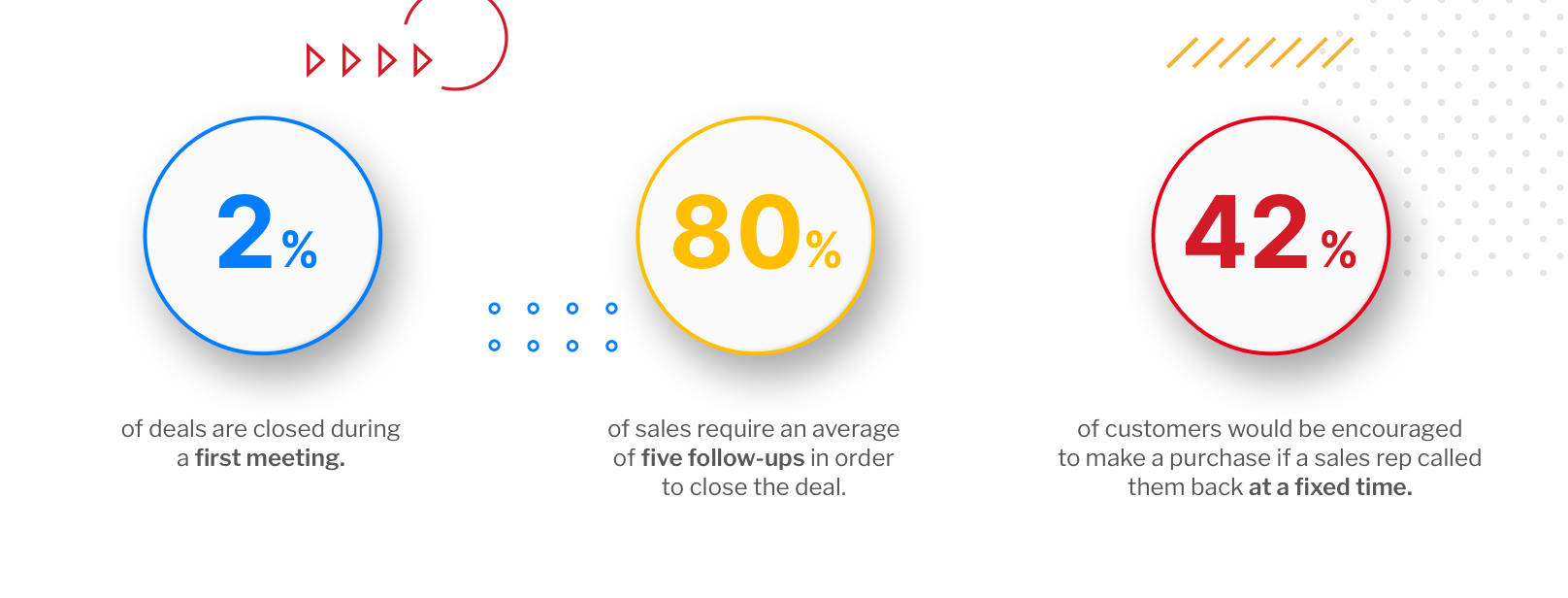
If you need more arguments, you should know that sending follow-up e-mails can encourage more people to buy your products. According to Invespcro, you can gain more than 42% of customers by doing that.
The lack of follow-up e-mails is the best way to lose new leads, and as you know, lead-generation campaigns are not the cheapest ones.
Why is it good to follow up with a client after a meeting?
- You prove to your customers that they are important business partners and you want to continue the collaboration.
- If you follow up with your clients, you check whether they are interested in your offer. Furthermore, you gather data about their needs and problems.
- If your customer comes across some difficulties, you know about it in advance. Therefore, you can react in a good moment. Thanks to this, you guide your customer through different stages of a sales funnel, and take care of customer experience.
- Sending follow-up e-mails is not difficult, especially, if you use automation tools that make it faster.

- If your customer is busy, you remind them of the details of the offer and solutions that you propose. As a consequence, you affect the buying process and speed up making a buying decision.
- Your client can be unavailable because of holidays or different circumstances. Just be patient and do not lose your motivation.
- You are better than competitive companies! According to the data of Invespcro, about 44% of sales reps do not pursue contact with a customer after an initial call or a meeting. Furthermore, only 8% of salespeople follow up with clients after meetings. Therefore, they lose the opportunity to turn leads into qualified prospects.
How often do you need to follow up with your customer?
You know that your persistence can pay off, and statistics prove it. But how often do you need to send follow-up e-mails to be successful? Unfortunately, there is no universal solution for everyone.
It depends on the size of the company – small businesses usually cooperate with similar partners, which means a limited number of follow-up e-mails. They want to save time and every delay matters to them.
On the contrary, if we look at big companies, we can see that closing a deal requires even dozens of follow-up e-mails.
It is essential to follow up with customers after meetings, but you must remember not to exaggerate. You are a sales rep, and it is obvious that your mailbox is full of messages. Think twice before you send an e-mail automatically. It is possible that your customer has already responded and you did not even notice it.

Sales funnel stages and sending follow-up e-mails
A sales funnel is a helpful tool that will show you how often you should send follow-up e-mails. You are a sales rep and probably you know what the meaning of a sales funnel is. Maybe you have heard about its stages. However, do you know all the details?
How does a sales funnel affect the sales process? Do you know how to create a sales funnel? What factors influence the final purchase? What is the meaning of a lead magnet? How does a sales funnel work? There are numerous topics that you need to explore.

A sales funnel is not only a visual representation of the sales process. Moreover, it is not only helpful in marketing activities. Understanding the mechanisms of a sales funnel will help you comprehend how potential customers move through it. If you know the reasons for their behavior, it will be easier for you to plan follow-up e-mails.
It is time to learn more about a well-defined sales funnel and its role.
What is a sales funnel and how can it be helpful?
A sales pipeline or sales funnel consists of different levels which describe the steps of existing customers before they become paying customers. The effective sales funnel tells about the activities of a given company and their impact on the sales performance. It should reflect the sales cycle and its elements.
However, you should remember that sales funnels are not universal. Therefore, every sales funnel should be created individually for a given business. Its structure depends on the type and size of the company. Why is implementing a sales funnel important?
A sales funnel allows sales teams to organize their work better, affect conversion rates, and improve the sales and marketing process. If you know what activities are effective, you can focus on them.

Well-defined sales funnels and their roles
If your company has a well-defined sales funnel, it will be easier for you to choose the right moment for sending follow-up e-mails. A good sales funnel helps you know what your target audience is. You will find out what your clients do at every stage of the sales and what their customer journey is.
Furthermore, you will know how often to nurture your qualified leads and what marketing efforts are effective. Solid knowledge about the activities of new and current customers is essential if you want to maintain good relations with them and build customer loyalty.
What are the elements of a successful sales funnel? What happens at every stage of the sales funnel? You will find the answers in the rest part of this article.
Why is it good to pay attention to the sales funnel before following up with a client?
As we have said, there are no universal sales funnels. However, there are certain elements repeated in general models of them.
We have already written about a sales funnel on our blog, therefore, in this article, we only mention several essential aspects.
According to the general AIDA model, there are several sales funnel stages – attention, interest, desire, and action. However, it is not the only model of a sales pipeline.
There is also a model called ToFu – MoFu – BoFu, where ToFu means the top of the sales funnel, MoFu means the middle of the sales funnel, and BoFu means the bottom of the sales funnel. The ToFu, MoFu, and BoFu levels reflect the structure of a sales funnel.
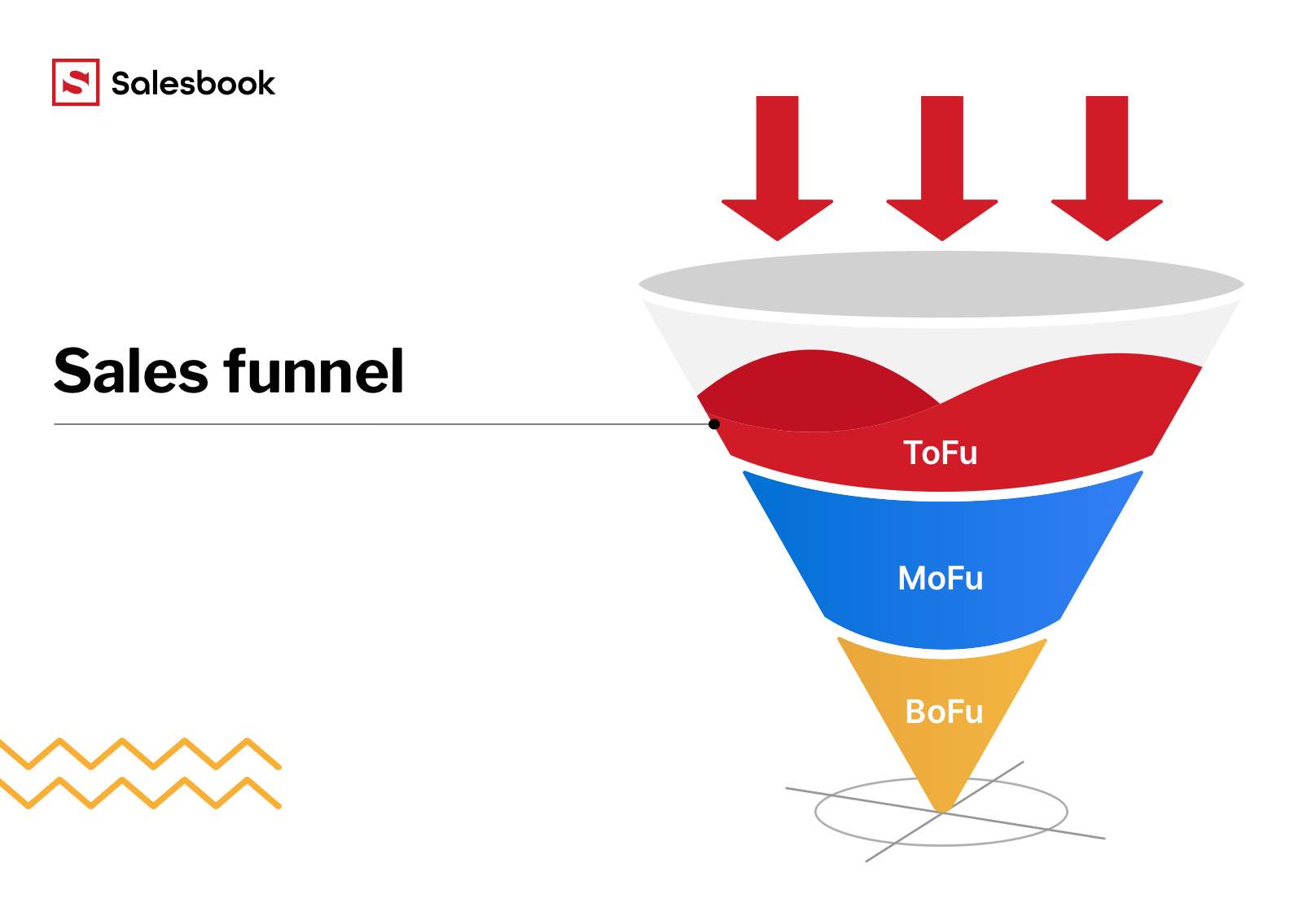
Those sales funnels above are models which are associated with a general sales cycle. However, the sales funnel that is suitable for a specific sales process should take more aspects into consideration.
The specific model of the sales funnel consists of the following stages:
- lead generation,
- contact,
- lead qualification,
- presentation,
- offer,
- negotiations,
- contract.
At every stage of the sales funnel, you should consider your way of communication. Why is it so essential? Sales funnels work best if they are built for a defined audience.
If you work on your communication strategy and adapt it to your audience, it is easier for you to estimate the number of follow-up e-mails. By choosing the suitable form of writing you are certain that your words do not fall on deaf ears.
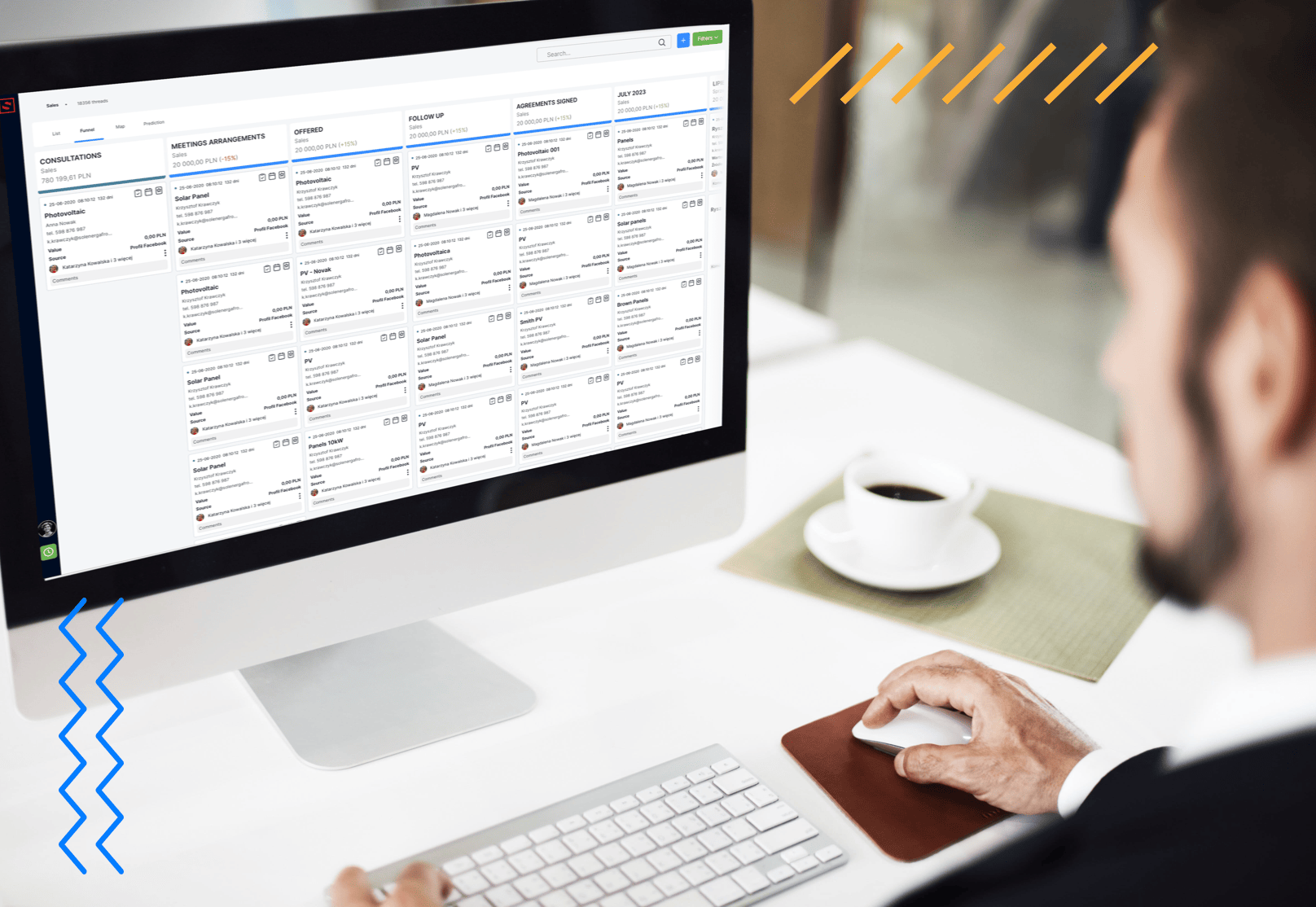
What happens at every stage of the sales funnel?
Every sales team and sales rep should have detailed information about a sales funnel, therefore, we remind its basic structure. You need to be aware of that if you want to create a sales funnel on your own. Let’s take a look at levels of sales funnel.
The top of the sales funnel
The sales funnel starts with a large number of potential customers. If you want to gather a lot of people (new leads), you need to analyze your target audience and know their interests. This is the moment of lead generation. You can generate leads by spending money on a successful and outstanding marketing campaign.
The top of the sales funnel is also an awareness stage – your prospective customers can visit your landing page and other sales pages. Moreover, they can click on your ads and attend a webinar to gain more information. It is a result of your activities.

If your marketing efforts pay off, your next step will rely on contacting potential customers, turning them into qualified prospects, and making predictions about future purchases.
Do not remember about lead management. Your task is also to qualify your new leads. In the next stage of the sales funnel your prospects move on to the interest stage.
The middle of the sales funnel
The sales funnel begins with your customers’ awareness, However, at this stage of the sales funnel your customers are eager to know more about your products or services. They can be your target audience, but you need to remember that they conduct competitive research to know if other companies satisfy their needs too.
At this stage of the sales funnel, you need to provide your target audience with more information about your product or service, invest money in e-mail marketing, and have good content on your landing page. It is your chance to present your offer in an attractive way and build customer loyalty. Your website visitors can be your paying customers.

The bottom of the sales funnel
This is the final stage when your prospects drop off and you have only several customers. They are really interested in your offer and have vast knowledge about your product or service.
At this stage of the sales funnel, you should be an expert to turn a potential customer into a paying customer. Answer all questions and explain all details. Your client is about to make a decision. It depends on your determination what the result will be.

It may seem that everything will be easy because this is the last stage of the sales funnel. But, do not forget that this phase of the sales pipeline is also demanding and can give you a rough ride.
If you plan meetings, do not forget about them and be punctual. Always be prepared and call your customer every time you feel that they do not understand the details of your product or service. Do not forget to send follow-up e-mails.
Now you have complete knowledge about a sales funnel and its stages. You are aware of what your customers can expect and how they can behave on different levels of a sales funnel. If you want to be a successful sales rep, make use of this information, and do not forget about the significance of following up with customers.
You would be surprised how many mistakes salespeople can make when they write follow-up e-mails.
The biggest mistakes while sending follow-up e-mails
- You do not think about the sales cycle in your company. You are aware that there is something called the sales funnel but you do not have time to explore the topic. Maybe the sales funnel helps get to know customers better, but you believe in your own myth – you are an experienced sales rep and do not need any guidelines. Obviously, you do not consider your way of communication. You often write e-mails in hurry and do not focus on your style of writing.
- You do not send follow-up e-mails at all. Sometimes you tell your customers that you will send them a summary(additional information about the product or service), but you never do it.You are not a reliable partner in business. How can you expect that your customers will treat you with respect?

- You do not think about the content of your follow-up e-mails. Your messages are too general. You are of the opinion that customers can read the rest on the landing page. The language that you use in e-mails is not plain. Your clients have problems to understand you.
- Your e-mails do not refer to prior meetings, you do not title your e-mails, therefore, your customers have difficulties finding them in their mailbox.
- You do not use automation that could improve your work and make sending e-mails easier.
How to send automated follow-up e-mails with Salesbook?
Modern sales automation tools can improve your work. According to our data, almost 30% of salespeople spend an hour a day typing data into a CRM system.
If you write summaries and send follow-up e-mails after meetings, then the time devoted to such activities can be even longer.
The app from Salesbook supports the work of salespeople and sales teams. If you use it, you can create ready-made templates and plan your workday in advance.
Have more time thanks to automation
On account of the fact that you create your content in advance, you can send an e-mail soon after a meeting. Sending automated follow-up e-mails is easy and does not take much time.
You can create lists of follow-up e-mails and choose the most relevant template.
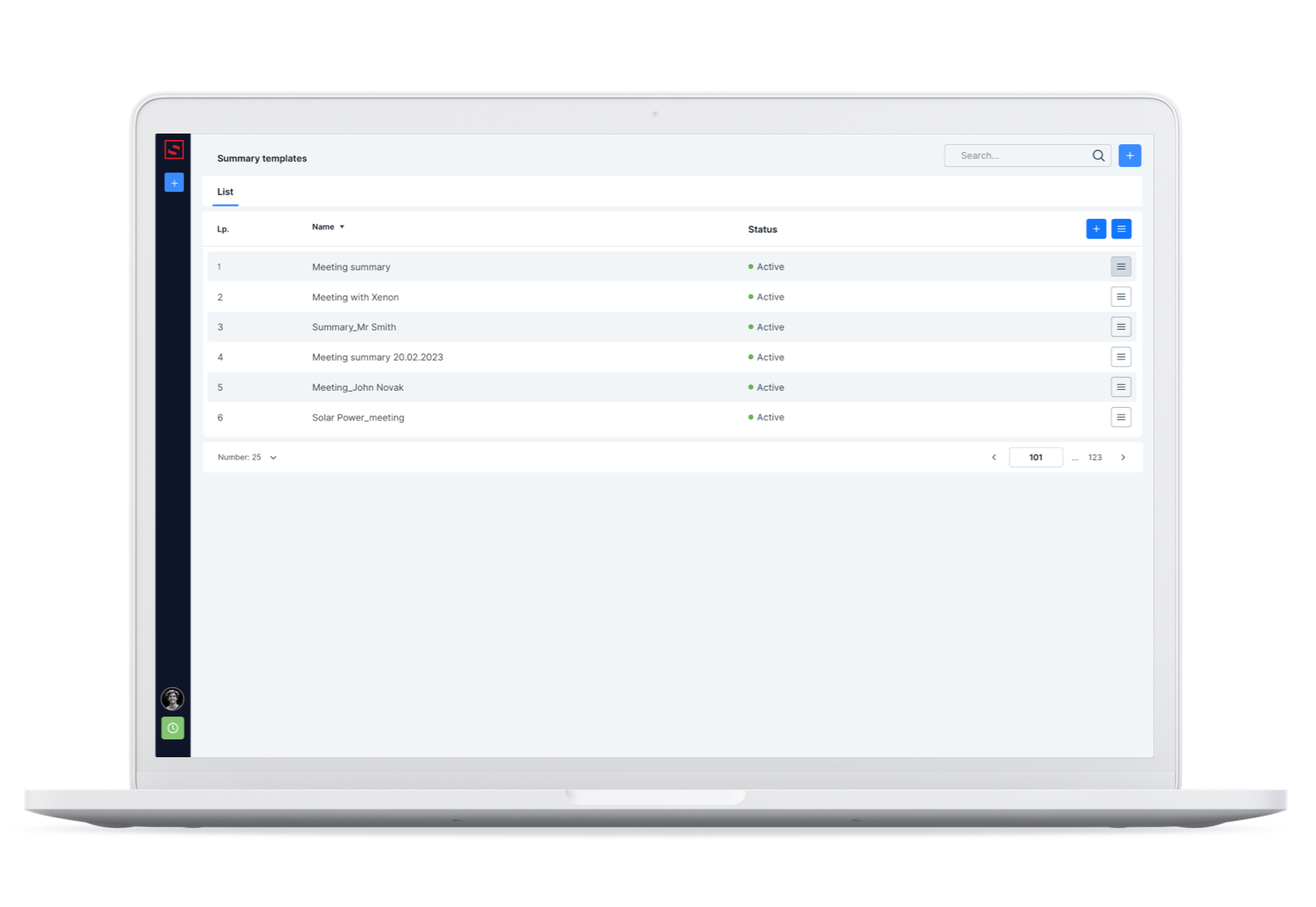
You can change the content of follow-up e-mails and add necessary attachments.
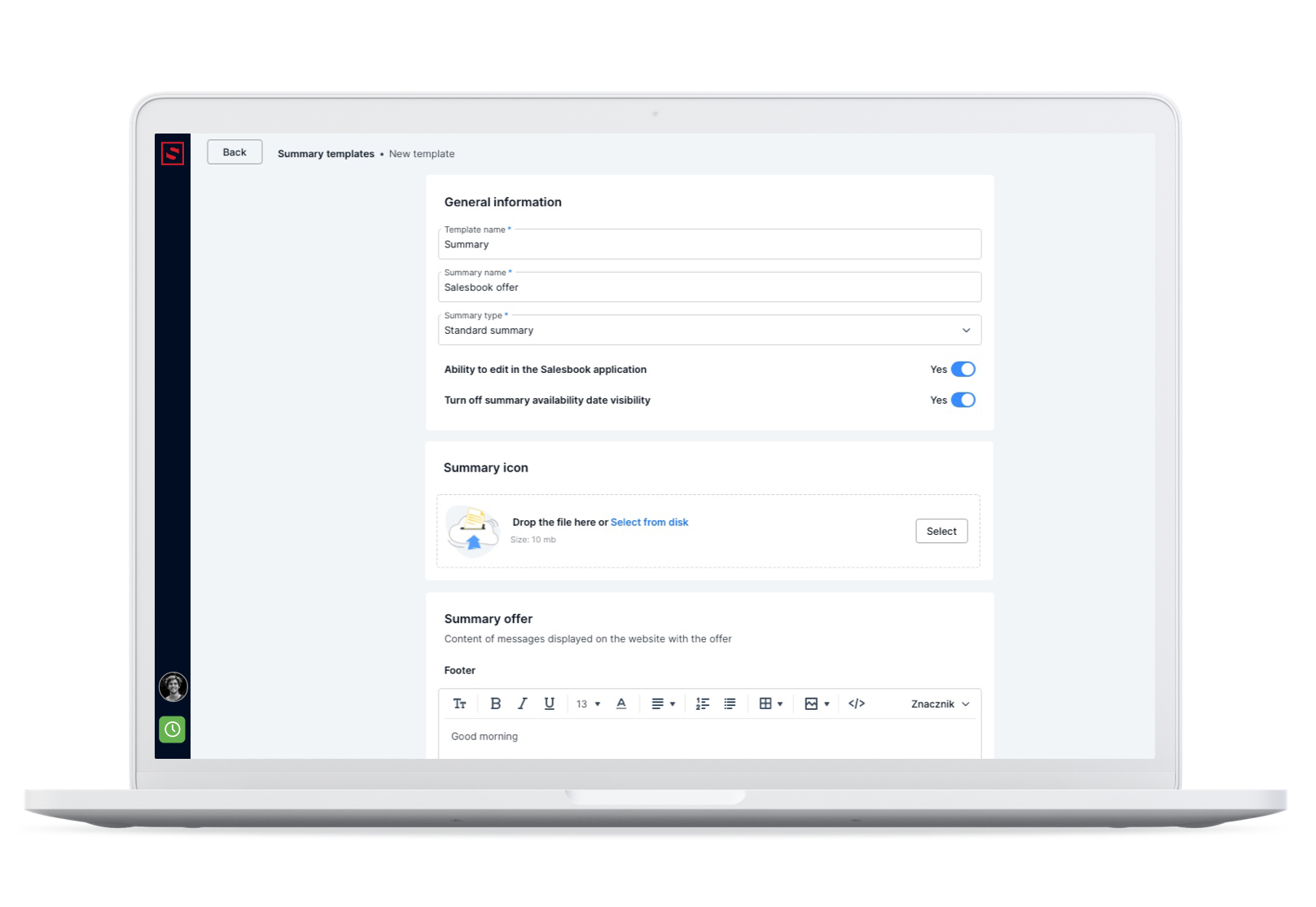
If you have a ready-made template, you can use it several times. You do not have to write an e-mail every time to send it. Adding a personalized icon helps you find a given template.
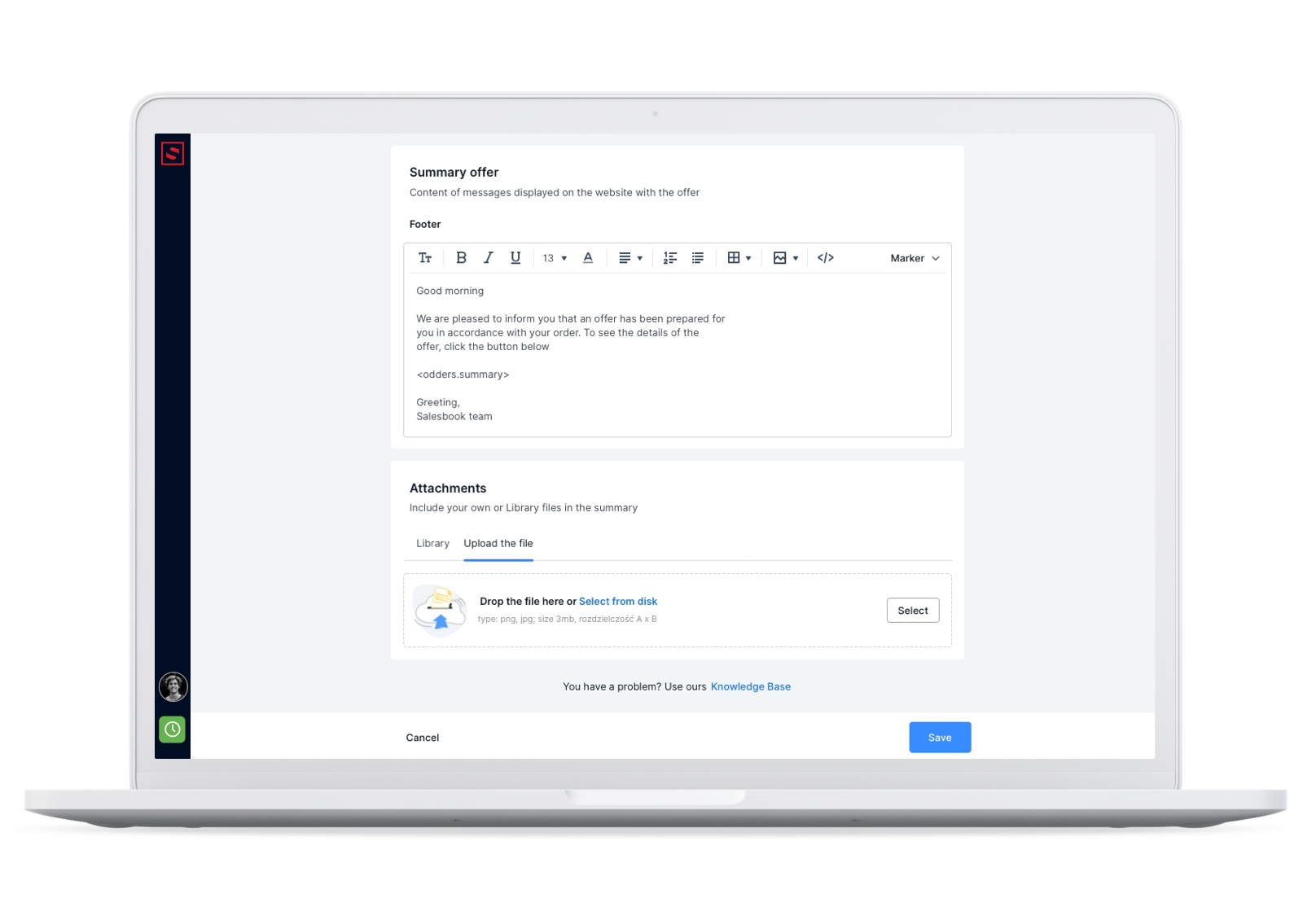
Check if your sales team sends follow-up e-mails
If you are a sales manager and want to be sure that sales reps send follow-up e-mails, you can put these kinds of messages in a sales funnel. So, thanks to this, you will know if their number is enough and if there is a salesperson who does not send them.
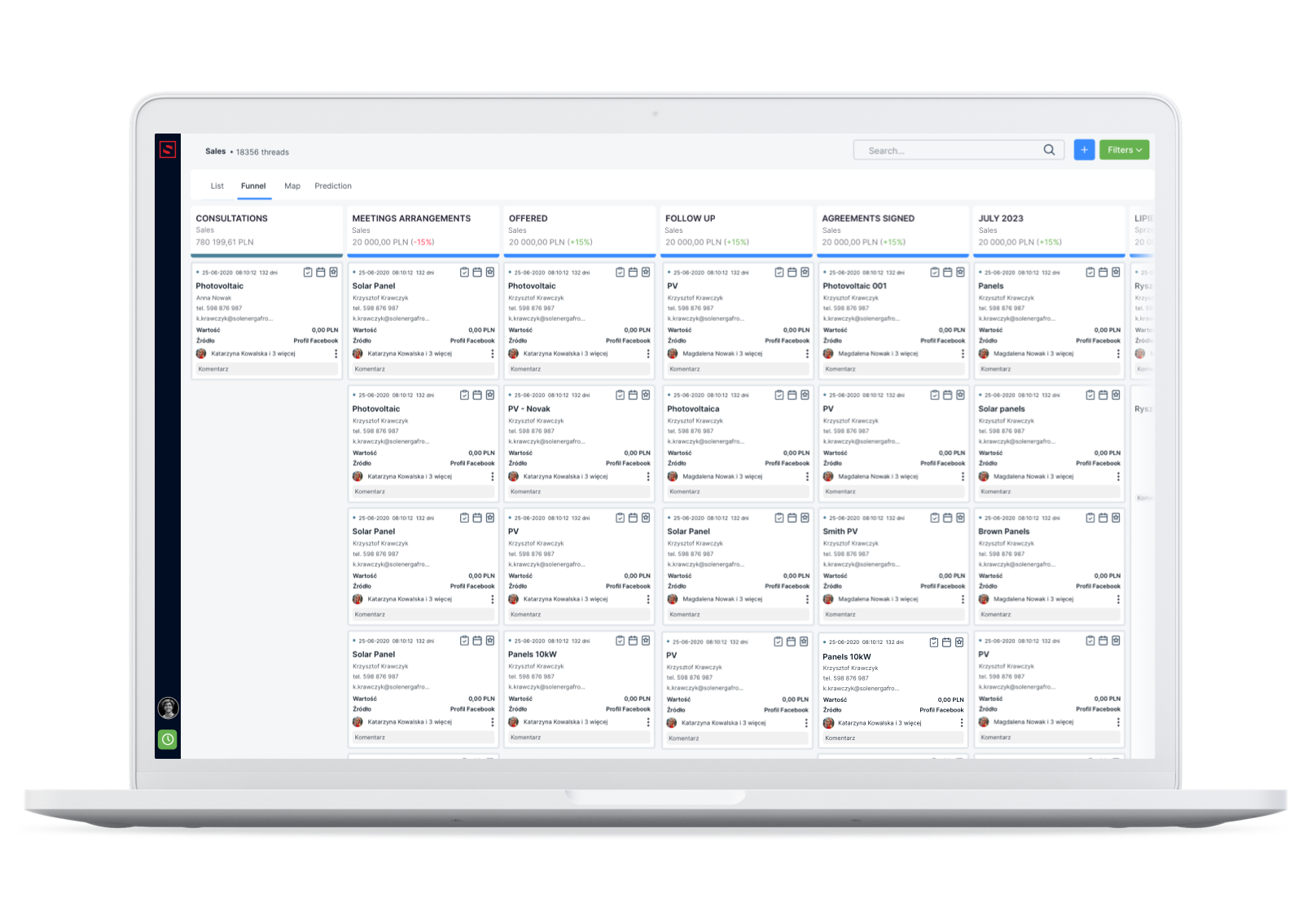
Every time you can check the details of follow-up e-mails, notes, tasks, or frequency of meetings.
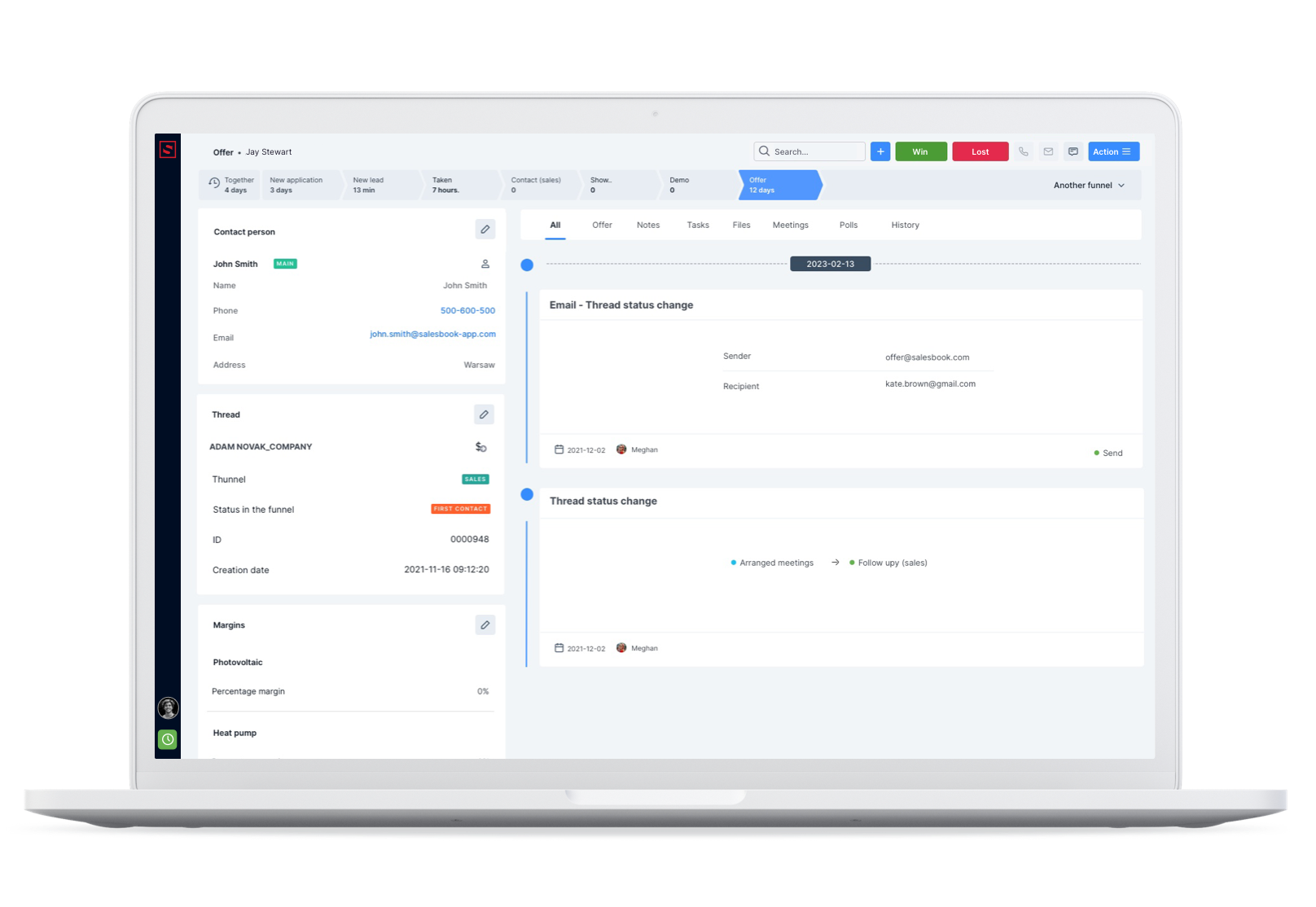
If a client does not respond, you can remind them about the answer and send an SMS.
Send automated SMSes
Before you call your customer – set up an automated SMS in a system. It is a good solution to remind your client of your cooperation, offer, and that you wait for their decision.
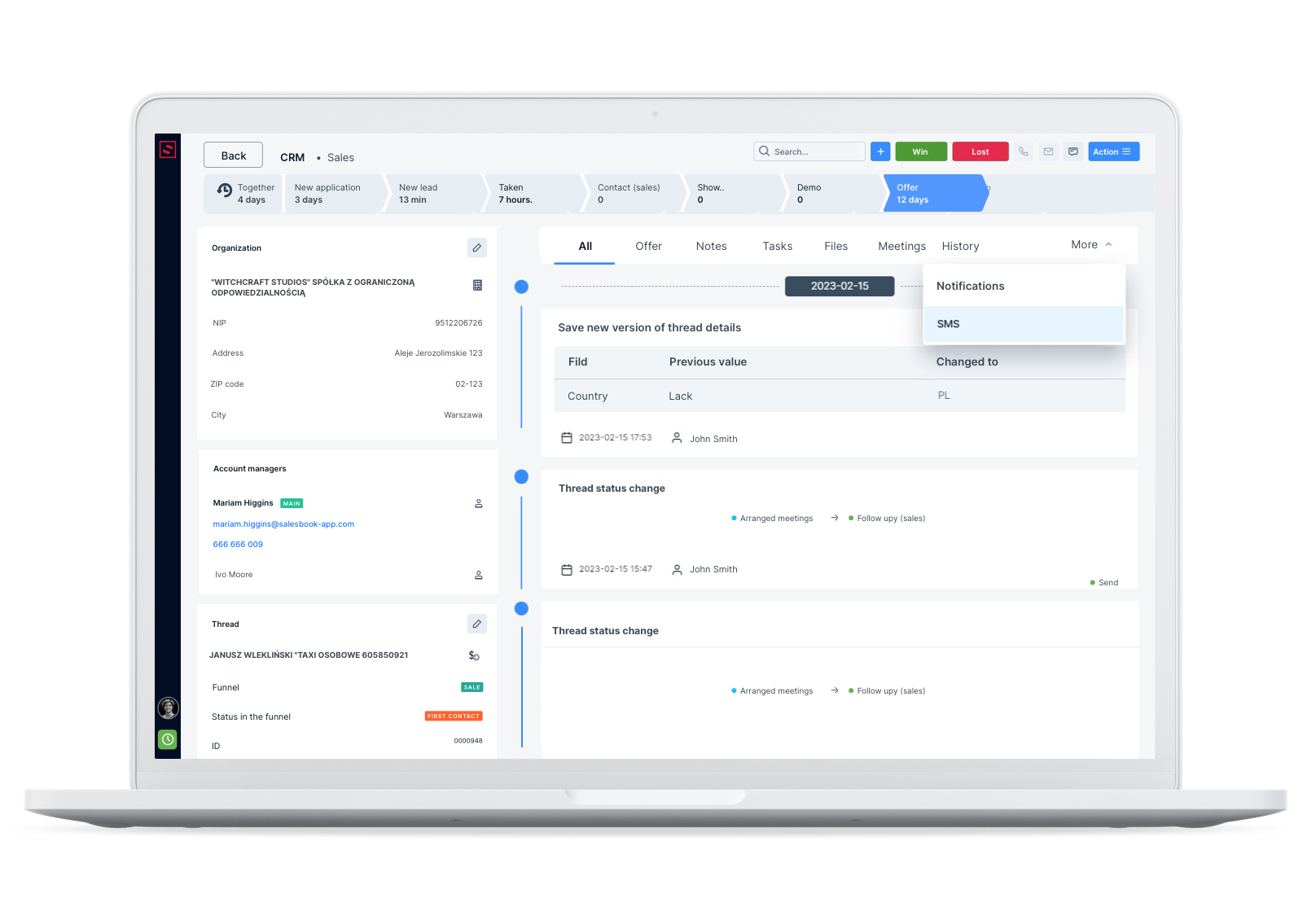
Summary
As an experienced sales rep, you spend long hours making conversations and arranging meetings with customers and do your best to close deals.
You are aware that different levels of a sales funnel are significant and how they are related to your customers’ behavior. You build relations with clients and take care of customer experience.
Sending follow-up e-mails will allow you to reach your sales goals and help maintain good contacts with clients. If you use modern tools, you do not waste your time on mundane tasks.
Check what Salesbook can do for you
Salesbook is a modern tool that allows you to reach your potential client, plan effective follow-up e-mails, and send them automatically.
So, if you want to check Salesbook, try the free demo.
Table of Contents


